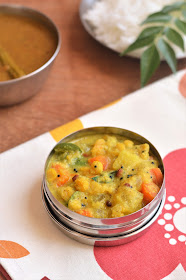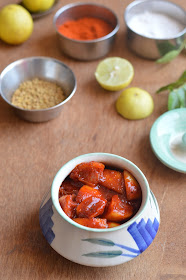My blog has been lying dormant for quite sometime. Diwali,
the festival of lights is knocking at our doors. Now, Diwali calls for a couple
of posts. So I finally, started my Diwali preparations today. I started out by
making this delicious sweet – Badusha. These are small doughnut shaped sweets,
crisp and coated with sugar on the outside and juicy on the inside.
I have grown up seeing my grandfather, religiously prepare
these, for almost every Diwali. He was an expert in making these. My
grandmother and mother were his so-called assistants. He would do the major
work of kneading the dough and take help from them to shape the badushas. I
still remember him frying the badushas in large steel “thalam”/ “thambalam” so
that all badushas got the same amount of heat and fried well. He used
Vanaspati/dalda to prepare them. With changing times my mother has slightly
altered the recipe and uses ghee instead.
Let us move on the recipe
Makes – 30 medium sized badushas
What you’ll need
- All Purpose Flour/Maida – 4 cup
- Ghee – ¾ cup
- Curd – 8 tbsp
- Salt – a pinch
- Cooking Soda – 1 tsp
- Oil for deep frying
For the sugar syrup
- Sugar – 2 cup
- Rose Essence – few drops or Powdered Cardamom – 1 tsp
Method
- In a wide vessel, add ghee and cooking soda and rub it very
well with your finger so as to mix the soda well with the ghee.
- To this add the curd and mix well.
- Now sprinkle the maida little at time and bring it together
into a dough.
- Add a little water and make into a smooth dough. Do not
apply too much pressure while kneading.
- Cover and rest it for at least 30 minutes.
- Now, pinch out small lemon sized balls, roll into smooth
ball, flatten slightly with your palm and make an indent with your thumb in the
centre.
- Repeat this with the rest of the dough
- In the meanwhile, heat oil for deep frying in a kadai. Once
the oil has heated up, (test by adding a tiny piece of dough, it should come up
immediately), turn off the heat.
- Slide in 3 to 4 pieces of the shaped dough into the oil and
let it cook in the pre-heated oil for a while.
- Now, turn the stove on, and cook on low heat, by flipping
and turning the badhushas, until they have turned a nice golden brown, or until
the sound stops.
- Drain into a tissue paper.
- Simultaneously prepare the sugar syrup, heat another kadai,
add the sugar and water enough to submerge the sugar. Heat it until one string
consistency and remove from heat.
- Add the rose essence or cardamom powder mix well.
- Soak the first batch of badhushas in the syrup until the
next batch is ready.
- Remove the first batch from the syrup and line them up in a
wide plate.
- Repeat the above until all the badushas are fried and dipped
in sugar syrup.
- Now, keep the remaining sugar syrup on heat again and keep
stirring, till it turns into a white saucy liquid.
- Remove from heat, and dip all the badushas in this white
crystal sugar, place them on a wide plate and let them cool for at least a
couple of hours.
Delicious badushas are ready.
Notes:
- The last step of dipping the badhushas again in the crystal
sugar, is optional, if you like your badhuha like the store bought ones, stop
at step 15. But my grandfather used to proceed and make this way and we like it
this way.
- Take care not to add too much water while kneading, use as
little as possible. Also, do not knead like chappati dough giving a lot of
pressure.





















